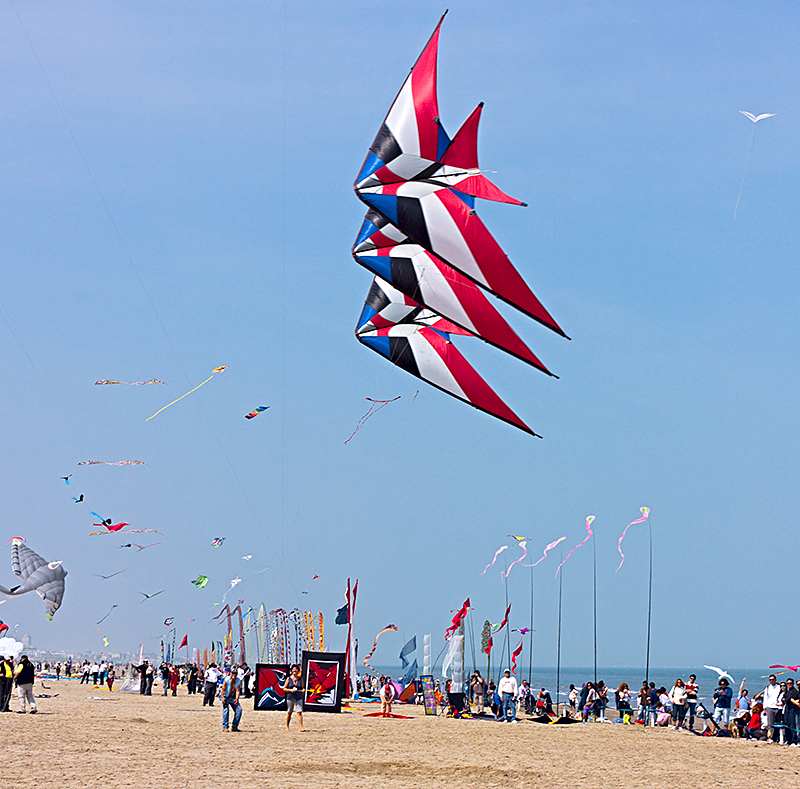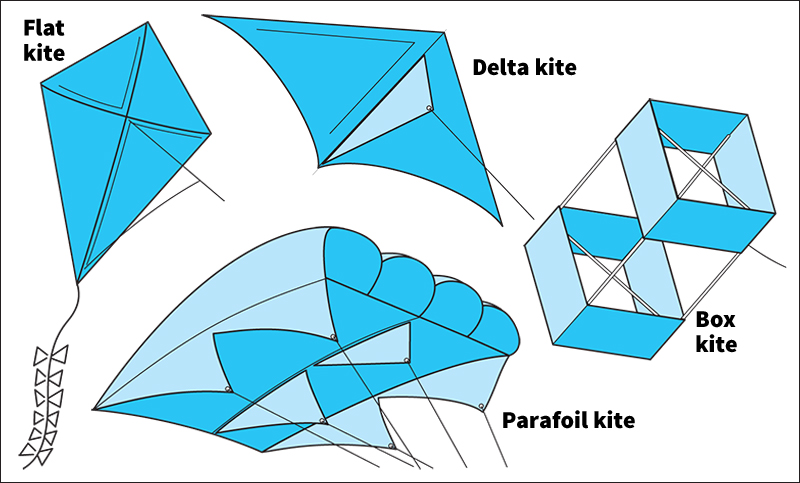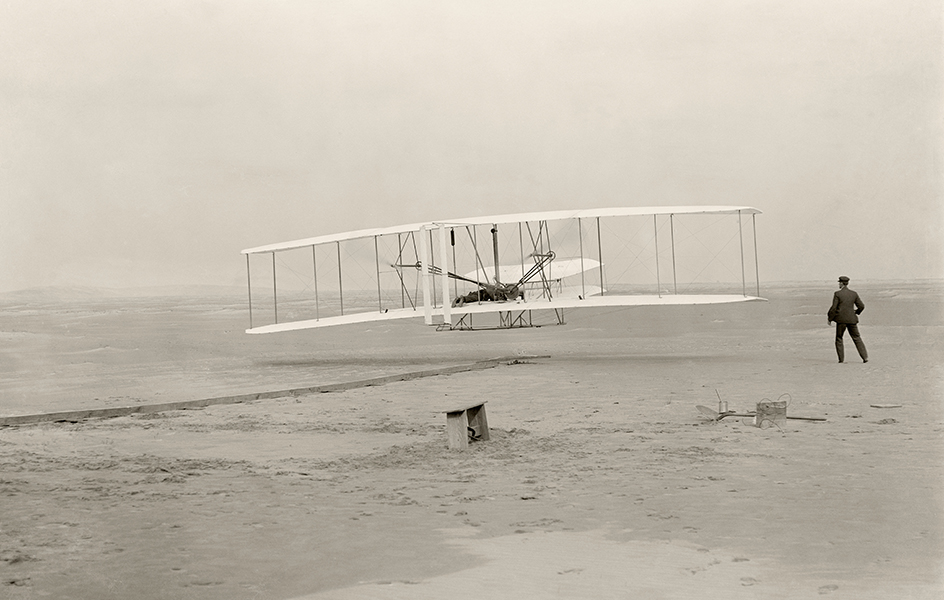Kite is an object that is flown in the air at the end of a line. The name comes from a graceful, soaring bird called a kite. Some kites consist of material such as paper or cloth mounted on a frame made of sticks, to which a line or lines are attached. However, many kite builders use synthetic coverings, such as plastics or nylon, that are lighter and more durable than paper or cloth. They also use fiberglass or aluminum instead of wood for the frame. The lines may be nylon, polyester, or other synthetics, or cotton. Kites can be made in hundreds of sizes, shapes, and colors.

Most kites today are made and flown for recreational purposes. For example, in Hamamatsu, Japan, people fly brightly painted kites taller than adult human beings in a festival over 400 years old. Kites have also been used for scientific research and for military purposes. Kites carrying measuring devices into the sky helped develop the science of weather forecasting in the 1800’s. During World War II (1939-1945), life rafts carried box kites that were equipped with radio antennas in order to send out S O S signals.
How kites fly
A kite’s ability to fly in the wind depends on its construction and the way its lines are attached. For example, the well-known diamond-shaped kite flies when its covered side is facing the wind. The lines should pull the nose of the kite into the wind, creating the necessary angle against the wind. This angle is called the angle of attack. If the kite’s construction and angle of attack are correct, the kite will strike the air with greater pressure against its face than against its back. The difference in air pressure between the face and back surfaces creates lift, which is the force that makes the kite rise. The resistance of the air to the forward motion of the kite is called drag. The forces of lift, drag, line tension, and gravity combine to keep the kite in the air.
Most kites fly from a bridle. The bridle consists of two or more short lines, called legs, that attach the kite to the flying line. The place of attachment, called the towing point, sets the kite’s angle of attack. The bridle also distributes stresses on the kite to help the kite keep its shape and fly. A kite must be headed up and into the wind. It can maintain this position in several ways, such as through a tail, a rudder, a keel, tassels, vents, or combinations of these.
Types of kites
There are hundreds of different types of kites. The most basic types include (1) flat kites, (2) bowed kites, (3) box kites, (4) delta kites, and (5) flexible kites. Stunt kites look similar to other kites but are built to be more precisely controlled in flight.

The flat kite
is the oldest basic type of kite. Flat kites need tails to supply drag and keep the kite pointed toward the sky. A simple tail consists of cloth strips tied end to end. Strips can be added or removed as needed. The more wind there is, the more tail is needed. A kite should begin with a tail at least seven times its diagonal length.
The bowed kite
is curved on its face to create an angle into the wind, called the dihedral angle. This angle provides stability without the need for a tail. A favorite bowed kite is the two-stick diamond-shaped kite patented in 1891 by an American named William A. Eddy. In India and other countries, fighter kites, which become bowed in the wind, are used in the sport of kite fighting. Participants attach glass-coated lines to their kites and maneuver them in attempts to cut down opponent kites.
The box kite
consists of three-dimensional units whose sides are squares, rectangles, or triangles. The units can be combined in countless ways. Most box kites require strong, steady winds to fly. When several are flown on one flying line or in a train, the pull can be great enough to lift a person off the ground. Lawrence Hargrave of Australia invented the box kite in 1893.
The delta kite
is roughly triangular. Most delta kites have a flap of material, called a keel, which is perpendicular to the surface. The keel works as a bridle and attaches to the flying line. Delta kites are easy to build, and readily fly in light winds.
The flexible kite
is sewed or taped together in a design that takes shape when the kite is filled with wind. An example is the parafoil, which is similar to a parachute and consists entirely of fabric. It has no rigid frame. A complicated bridle with many legs attaches the parafoil to the flying line. The kite was invented by Domina C. Jalbert of the United States in 1963.
Stunt kites
resemble basic types of kites but can be operated with more precision to perform complex acrobatics. Most stunt kites have two flying lines attached to the bridle and are called dual-line control kites. Quad-line kites have four flying lines. Stunt kites can be manipulated to do such stunts as figure eights, sharp turns, or stops in the air, or flying backward.
Flying a kite
Kites should be flown in open, unobstructed spaces. Good locations include schoolyards, parks, farm fields, empty parking lots, and beaches. Kites should not be flown on public streets and highways, in areas where kites would interfere with airplane traffic, on bumpy or rocky land, or near trees.
Kite fliers should follow several safety rules. Never fly kites in stormy or wet weather because static electricity can travel down the flying line and injure–or even kill–the person holding the line. Never fly a kite near electric lines or antennas, or use any metal in the kite lines. By wearing gloves, kite fliers may prevent line burn, which is caused by the kite cord pulling too quickly through the fingers.
Before flying a kite, make sure that the kite has been properly assembled. Also, take along extra supplies, such as tail materials, line, and a winder for the line.
Some kites need only a light breeze of 3 or 4 miles (5 or 6 kilometers) per hour to fly. Others require wind speeds of more than 10 miles (16 kilometers) per hour. Judge the wind from the movement of tree branches. A wind speed of 25 miles (40 kilometers) per hour is too strong for most kites.
Two people–a launcher and a flier–provide the easiest way to fly a kite. The launcher walks the kite away from the flier at least 50 feet (15 meters). The wind should be at the flier’s back and in the launcher’s face. After pulling the flying line so there is no slack, the flier signals to the launcher to release the kite. If everything is correct, the kite will rise easily into the sky. The flier should keep tension on the flying line but allow it to feed out smoothly.
If the wind drops, repeated hauling on the flying line will force the kite up into higher breezes, which are usually steadier. The flier need not run with the kite if there is enough wind. If the kite begins to tumble, the flier should slacken the flying line. This helps the kite regain stability and prevents it from diving and crashing to the ground. When ready to bring the kite in, the flier should walk to the kite while pulling the flying line in, and then wrap the line on the winder.
History
Kites are the oldest form of aircraft. They probably originated in China more than 2,000 years ago. During the Han dynasty (206 B.C. to A.D. 220), the Chinese military attached bamboo pipes to the kites. As the kites flew over the enemy, wind passed through the pipes, causing a whistling sound. The noise caused the troops to panic and flee.
In 1752, the American statesman and scientist Benjamin Franklin made the kite famous when he described how he used one to prove that lightning is electricity. Franklin wrote how he attached a metal key to the flying line of his homemade kite. During a thunderstorm, the air became electrified, and an electric charge traveled to the kite and a pointed wire fastened to the kite. The spark traveled down the flying line to the key. The spark proved Franklin’s theory.
In 1847, a kite helped pull a cable across the Niagara River between the United States and Canada. The cable was part of the river’s first suspension bridge.

Alexander Graham Bell, the inventor of the telephone, also created kites. He hoped they would lead to aircraft that would carry people. He used tetrahedral (four-faced) box kites that could be combined in large forms for lifting human beings.
Kites have been used to measure the weather. From 1898 to 1933, the U.S. Weather Bureau (now the National Weather Service) operated kite stations. These stations flew box kites with weather-measuring devices.
Today, kites are used less often for military or scientific purposes. However, since the 1970’s, kites have gained interest as a pastime. Thousands of specialty kite shops exist throughout the world.
Kite flying is a year-round sport. Some kites are used to propel people in buggies or boats or on skates or skis. Kites are also exhibited in museums as works of art. Kite lovers worldwide form clubs and participate in festivals and other kite events. Several books, newsletters, and websites provide information about kites.
